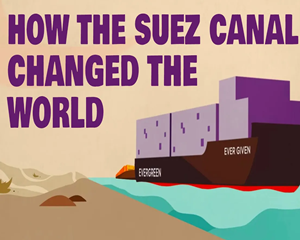(单词翻译:单击)
In March 2021, fierce winds blew a container ship off course.
2021年3月,狂风把一艘集装箱船吹偏离航线。
In most places, this would have caused a minor incident. But in the Suez Canal, it was a global crisis.
在大多数地方,这会造成一件小事。但在苏伊士运河,这是一场全球危机。
This vessel wasn't just blocking other ships.
这艘船不仅挡住了其他船舶。
It was obstructing the flow of international trade through one of the world's most important waterways.
它阻碍了国际贸易的流动通过世界上的一个最重要的水路。
The site of the Suez Canal has been of interest to rulers of this region as far back as the second millennium BCE.
早在公元前二千年该地区的统治者就对苏伊士运河感兴趣。
To move goods between Asia and the Mediterranean basin,
在亚洲和地中海盆地之间运输货物,
traders had to traverse the narrow isthmus separating the Red Sea and the Nile, journeying in camel-bound caravans through the unforgiving desert.
商人不得不穿越分隔红海和尼罗河的狭窄的地峡,骑着骆驼的大篷车上穿过无情的沙漠。
A maritime passage between the Indian Ocean and the Mediterranean Sea would bypass this trip altogether.
在印度洋和地中海之间的海上通道将完全绕过这次旅行。
And throughout the 16th century, multiple powers attempted to construct such a canal.
在整个16世纪,多个势力尝试建造这样一条运河。
But their plans were obstructed by cost, political strife, and the ever-shifting sands.
但他们的计划被成本、政治冲突和不断变化的沙子阻碍。
In 1798, interest in building a canal was rekindled, this time attracting attention from across Europe.
1798年,对建筑一条运河的兴趣被重新点燃,这次引起来自欧洲各地的注目。
Over the following decades, individuals from Austria, Italy, Britain, and France pitched their plans to Egypt's rulers.
在接下来的几十年里,来自奥地利、意大利、英国和法国的人向埃及的统治者提出了他们的计划。
At the time, Egypt was a territory of the Ottoman Empire, which was resistant to these proposals.
当时,埃及是奥斯曼帝国的一个领土,它抵制了这些提议。
But Egypt's political and economic autonomy was gradually increasing, and its government was eager to pursue the project.
但埃及的政治和经济自主权逐渐增强,它的政府渴望去追求这个项目。
When Sa'id Pasha came into power in 1854, he approved a plan from the enterprising and manipulative French diplomat Ferdinand de Lesseps.
1854年赛义德·帕夏上台时,他批准了进取和操纵的法国外交官费迪南德·德·莱塞布提出的一个计划。
Signed in 1854 and 1856, a pair of concessions gave de Lesseps authority to establish the Suez Canal Company and finance it by selling shares to "capitalists of all nations."
分别于1854年和1856年签署,让步给了德莱塞布权力来建立苏伊士运河公司,并通过出售股票给“所有国家的资本家”为其融资。
The contracts between Sa'id Pasha and the Canal Company also promised a workforce of hundreds of thousands of Egyptian workers.
赛义德·帕夏和运河公司之间的合同还承诺了数十万埃及工人的劳动力。
Beginning in 1862, about 20,000 laborers were forcibly recruited every month, digging the canal in harsh desert conditions without easy access to food or water.
从1862年开始,每个月约有20000名劳工都被强制募,在恶劣的沙漠条件下挖运河不易获得食物或水。
Diseases like cholera ran rampant and workers toiled under the threat of whips.
霍乱等疾病肆虐,工人在鞭子的威胁下劳作。
The estimates of those who died during construction range into the thousands.
施工期间的死亡人数估计范围达数千。
In 1864, the new Egyptian ruler, Isma'il Pasha, put an end to the coerced Egyptian labor, but he still pressed forward with construction.
1864年,新的埃及统治者,伊斯梅尔·帕夏,结束强迫埃及人劳动,但他仍然推进建设。
Foreign workers from all over Europe and the Middle East labored alongside dredgers and bucket excavators to remove 74 million cubic meters of dirt.
来全欧洲和中东的外来工人,与挖泥船和斗式挖掘机一起工作,来清除7400万立方米的污垢。

This massive population of workers required infrastructure to deliver drinking water and other supplies,
这个庞大的工人群体所要基础设施来运送饮用水和其他用品,
giving rise to a flourishing economy of restaurants, brothels, and smuggled goods.
催生了餐馆、妓院和走私商品的经济。
Amidst the bustle were born three new cities with multi-ethnic populations:
喧嚣中诞生了三个多民族人口的新城市:
Port Said on the northern Mediterranean shore, Ismailia on the canal's middle tract, and Port Tewfiq, at the southern edge of the canal.
地中海沿岸北部的塞得港,运河中段的伊斯梅利亚,以及在运河的南端的图菲克港。
The construction site bypassed the Nile and ran directly from Port Said to Suez.
工地绕过尼罗河直接从塞得港跑到苏伊士。
And after years of work, the streams of the two seas finally began merging in the mid-1860s.
在1860年代中期,经过多年的努力,两海的溪流终于开始合并。
The finished canal was 164 kilometers long, with a width of 56 meters at the surface, and it was officially inaugurated on November 17th, 1869.
完成的运河有164公里长,地面宽56米,并正式在1869年11月17日开始使用。
While it struggled financially during its first few years, the canal ended up dramatically accelerating global trade.
虽然在它最初的几年里在财务上苦苦挣扎,但运河加快了全球贸易。
It also facilitated the migration of numerous marine species, dramatically changing local ecosystems and cuisine.
它也促进了众多海洋物种的迁移,极大的改变了当地的生态系统和美食。
Over the decades, traffic through the canal grew.
几十年来,通过运河的交通量增加了。
But in 1875, financial issues forced Egypt to sell much of its stock in the Canal Company, allowing Britain to take over.
但在1875年,金融问题迫使埃及大量出售其在运河公司的股票,并允许英国接管。
It was only in 1956 that control of the canal fully reverted to Egypt when it was nationalized by President Gamal Abdel Nasser.
直到1956年,运河才完全归还于埃及,当时正值被加迈勒·阿卜杜勒·纳赛尔总统国有化的时候。
This move sparked a military standoff between Egypt and Britain, France, and Israel.
此举引发了埃及还有英国、法国和以色列之间的军事对峙。
But once resolved, it transformed the canal into a major source of Egypt's national revenue and helped redeem the canal's imperialist legacy.
但一旦解决,运河会变成埃及的一个主要的收入来源,并帮助挽回了运河的帝国主义遗产。
Today, nearly 30% of all global ship traffic passes through the Suez Canal, totaling over 20,000 ships in 2021.
如今,全球近30%的船舶要通过苏伊士运河,到2021年,船舶总数超过20000艘。
However, the incident of the Ever Given is a stark reminder of just how fragile our manmade systems can be.
然而,“长赐号”巨轮事件是一个关于我们的人造系统可以有多么的脆弱的鲜明提醒。


